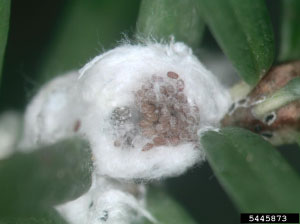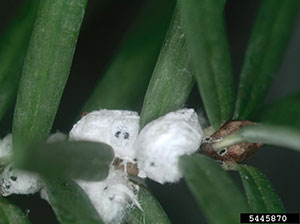Hemlock woolly adelgid is an aphid-like insect that attacks and kills hemlock trees. Its egg sacs, which look like cotton balls or clumps of snow, can be found at the base of needles. It can be spread by wind, animals, and human movement of nursery stock, logs, and other wood products including firewood.
Background
The hemlock woolly adelgid (scientific name Adelges tsugae) was first reported in the Eastern United States in the state of Virginia in 1951, where it was likely brought in on infested nursery stock from Japan. It has since spread and is now found in the east from northern Georgia to coastal Maine and southwestern Nova Scotia. Populations of HWA are also found in western North America, including Canada, where it has most likely been present for thousands of years. It is also found in Asia, where the adelgid is not a serious or particularly destructive pest because populations are kept down by natural enemies (predators and parasitoids) and by host resistance.
Damage to Western hemlock (scientific name Tsuga heterophylla) in British Columbia has been minor, due also to the combined action of natural enemies and host resistance. In the eastern United States, however, infestations of the adelgid on Eastern hemlock (Tsuga canadensis) and Carolina hemlock (Tsuga caroliniana) have resulted in significant levels of tree death, even destroying whole forests. All sizes and ages of trees are susceptible to attack by the adelgid, and its presence threatens the continued existence of these two tree species in many locations.
Plant pest card – Hemlock woolly adelgid
Hosts
Tree species known to be attacked by the adelgid are:
- Eastern hemlock (Tsuga canadensis)
- Carolina hemlock (Tsuga caroliniana)
- Chinese hemlock (Tsuga chinensis)
- Japanese hemlock (Tsuga diversifolia)
- Western hemlock (Tsuga heterophylla)
- Mountain hemlock (Tsuga mertensiana)
- Southern Japanese hemlock (Tsuga sieboldii)
- Himalayan hemlock (Tsuga dumosa)
- Yeddo spruce (Picea jezoensis hondoensis)
- Tiger-tail spruce (Picea polita)
Distribution
The adelgid is currently found in:
- Asia: China, India, Japan, Taiwan
- Canada: British Columbia, Nova Scotia, Ontario
- United States: Alaska, California, Connecticut, Delaware, District of Columbia, Georgia, Idaho, Kentucky, Maine, Maryland, Massachusetts, Montana, New Hampshire, New Jersey, New York, North Carolina, Ohio, Oregon, Pennsylvania, Rhode Island, South Carolina, Tennessee, Vermont, Virginia, Washington, West Virginia
Biology
In North America, the hemlock woolly adelgid is parthenogenetic, that is, there are only female adelgids and reproduction occurs without males. There are two generations per year, which have separate names, behaviours and appearances. The first one, called sistens (plural: sistentes), hatches in late spring, is wingless, lives through the summer, overwinters, and survives about nine months in total. The other, the progrediens generation (plural: progredientes), hatches in early spring, is comprised of both wingless and winged (called sexuparae) offspring, and survives for about three months.
The sexuparae fly from hemlock in search of a species of spruce (Picea) on which to deposit eggs. The sexuparae would usually produce males and females, but it is believed that they cannot find a suitable host on which to lay eggs, because the one they are looking for does not exist in North America. The sexuparae then die before sexual reproduction occurs. The lack of an effective winged generation means that the species cannot move on its own from area to area, and must rely on being carried (by wind, animals or humans) to other places. What helps it to spread rapidly is that the lifecycle of the adelgid allows for a rapid increase in population.
Shortly after the sistens eggs hatch, the first instar nymphs move to the bases of needles and immediately stop being active – they are dormant through the summer (this summer dormancy is called aestivation). As temperatures cool down in the fall, the sistens nymphs come out of aestivation and begin to feed and develop throughout the winter when temperatures are moderate. Adults begin to lay eggs in early spring, even sooner in warmer places like the southern United States.
During late fall and early spring, few natural enemies are active and hemlocks produce abundant quantities of sugar and amino acids, which provide good nutrition to the adelgids feeding on the twigs, leading to a high level of egg production. A single sistens female typically lays between 50 and 175 eggs (to a maximum of 300). The progredientes lay fewer eggs, typically between 25 and 125, but their offspring mature rapidly after hatching. Egg production in early spring and again in early summer has a multiplier effect on the population, which if unchecked by natural enemies or other factors results in very rapid population growth.
The form of the hemlock woolly adelgid in western North America is a separate lineage from the eastern form and is likely endemic, not exotic. Western hemlock species are tolerant to the presence and feeding of the western biotype of the adelgid, and natural enemies help keep it in check. The source of hemlock woolly adelgid in eastern North America has been reported to be a lineage of adelgids living predominantly on the southern Japanese hemlock (Tsuga sieboldii) at low elevations in southern Japan. Foresters in western North America are concerned about the potential introduction of the eastern North American biotype of the adelgid into the west, as it is not known if tree mortality would be as high as in the eastern United States.
Detection & Identification
Symptoms
- White "woolly" sacs resembling tiny cotton swab ends at the base of hemlock needles on young twigs; these are most obvious in the spring
- Premature bud and shoot dieback
- Premature needle loss
- Thinner, greyish-green crown (healthy crowns are a shiny, dark green colour)
- Dieback of twigs and branches
- Discoloured foliage
- Death within 4 to 15 years
Identification
- Egg: Oblong and amber in colour, and very small, roughly 0.36 mm long and 0.23 mm wide, with each generation (sistens, progrediens and sexuparae) slightly different in size from each other. Eggs of adult sistentes are laid in a single batch of up to 300 in a spherical woolly egg sac (ovisacs) made of white wax threads. Progrediens adults also lay their eggs (up to 250) in similar but smaller cottony ovisacs.
- Nymph: Sistens and progrediens: Very similar in size and appearance. The active crawlers (first instars) are about 0.44 mm long and 0.27 mm wide, reddish-brown with a small white fringe near the front. This stage's appearance peaks at the time of northward bird migration, and it is thought they can move long distances hanging on to birds. Within a few days they settle, at which time they are about 0.3 mm long, black with a white fringe around the body and down the back. Second-instar nymphs measure around 0.57 mm in length and 0.34 mm in width. Legs are short and thick; these and the following life stages are sessile, that is, they remain in one place and are not actively moving about. Third-instars are approximately 0.67 mm long by 0.43 mm wide, and fourth-instars 0.74 mm by 0.47 mm. Sexuparae: First instars similar in appearance to those of the sistens and progrediens first instars. Second instars and older nymphs are measurably larger than those of the other generations, but are still very small (about one mm long).
- Adult – Sistens: About 1.41 mm long by 1.05 mm wide, and are covered by a heavy waxy coat. Progrediens: Adults of this generation remain small, and are approximately 0.87 mm in length and 0.63 mm in width. Sexuparae: Measure around 1.09 mm by 0.51 mm. Dark brown in colour with long (five-segmented) antennae, compound eyes and four textured wings.




Consequences
In the United States, whole tracts of hemlock forest have been lost. Many birds and other wildlife species rely on hemlock. Hemlock shades forest streams from summer sun and allows cold-water fish like brook trout to survive, and it provides shelter for deer and birds in winter.
While the wood of hemlock is typically a niche product or only of local importance, the growing trees sequester carbon. Changes in the carbon cycle of a forest are a direct consequence of wide-scale tree deaths. The loss of hemlock will also affect cottage owners and rural property owners who have a large proportion of hemlock on their properties.
The northernmost extent of the adelgid's range is not projected to include the entire range of hemlock in Canada, but the insect is likely capable of adaptation over time, and may well catch up to its host. Climate change is also implicated in the northward expansion of the insect. Extreme cold events are still expected to eliminate some populations, or at least weaken local populations, leading to slower expected tree death in the northern part of its range, while drought and other tree stresses may hasten death.
Future
Test releases of a tiny ladybird beetle (Pseudoscymnus tsugae) that feeds on adelgids (the introduced ones, and the native balsam woolly adelgid and pine bark adelgid) are promising and may lead to natural control of the hemlock woolly adelgid. Laricobius nigrinus is another beetle in western North America that feeds on the hemlock woolly adelgid and is being investigated as a biocontrol agent. Some predatory beetles found currently only in Asia are also being tested, to see if they can be safely imported and released in North America. The future of hemlock woolly adelgid control will probably be a mixture of natural enemies and well-timed applications of specific pesticides, called integrated pest management.